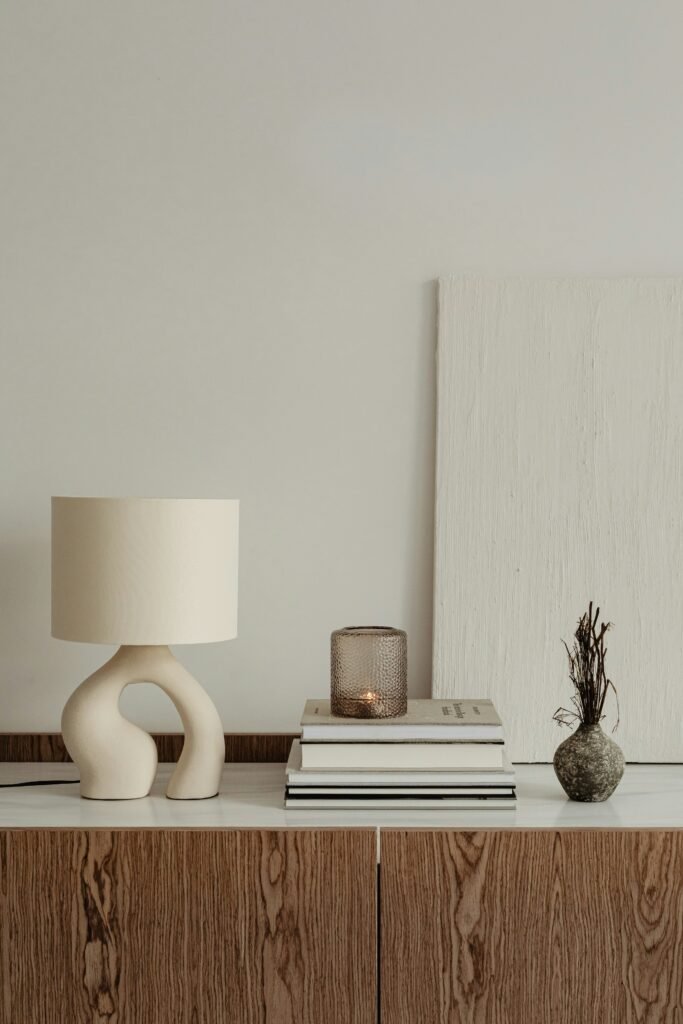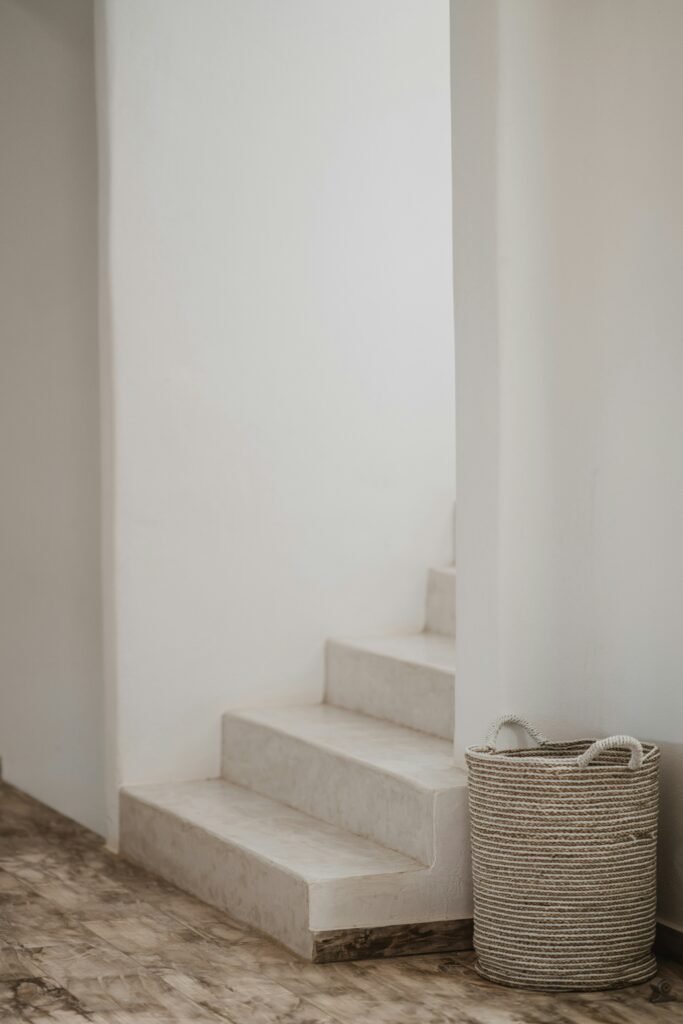How to create a calmer home without emptying it — or losing yourself in the process
Let me guess — whenever someone says “minimalist home,” your brain immediately jumps to that cliché image: white walls, a single chair, no personality in sight, and maybe one lonely cactus trying its best to survive.
If that’s your definition too… breathe. Because THAT kind of minimalism?
We’re not doing that here.
Minimalism has absolutely nothing to do with living in a house that looks like a hospital waiting room. It isn’t about throwing away everything you own or pretending you don’t enjoy coziness, color, or comfort. And it’s definitely not about judging yourself every time you buy a candle, a blanket, or a cute mug.
The real heart of minimalism is much softer than people think.
It’s simply about clearing the noise — the visual clutter that stresses you out, the emotional weight of things you don’t need, the objects you hold onto “just in case,” the endless stuff that fills your home but doesn’t add anything meaningful to your life.
Minimalism is about creating space to breathe.
Space to rest.
Space to live.
And the best part?
You can start gently, without pressure, without guilt, and without turning your home into a cold white box.
Here’s how to move toward a calm, cozy version of minimalism that still feels warm, personal, and very you.

1. Start With the Feeling You Want — Not the Look
Most people approach minimalism backwards. They look at pictures online, decide they need fewer things, and then start throwing stuff away like maniacs.
Please don’t do that.
Minimalism begins with one simple question:
How do I want my home to FEEL ?
Not “What should it look like?”
Not “What’s trendy right now?”
But: What feeling am I craving when I walk into my space?
Close your eyes and imagine it for a second.
Do you want a home that feels:
- cozy and warm?
- airy and open?
- soft and calm?
- simple and easy to maintain?
Once you know the feeling, everything else becomes easier.
Your decisions become intentional instead of impulsive.
If it helps, write down 3–5 words or make a small mood board. It doesn’t need to be fancy — screenshots from Pinterest, a few photos that inspire you, even colors or textures you love.
This becomes your compass.
Every time you hesitate about an object, ask yourself:
Does this belong in the home I want?
If the answer is no, you already know what to do.
2. Declutter Gently — One Tiny Space at a Tim
You do NOT need to empty your entire closet in one afternoon. You do NOT need to pull everything out of your kitchen in one overwhelming explosion of chaos. That method works for some people — usually the ones who already love cleaning — but for most of us, it leads straight to burnout and regret.
Try this instead:
Choose ONE tiny area
Not a room. Not a closet.
Just a drawer, one shelf, your nightstand, your makeup bag, the basket in your entryway — something small enough that you can finish in 10–15 minutes.
Then ask yourself:
- Do I use this?
- Do I enjoy this?
- Does this help me?
- Or is it just taking up space?
If it’s not useful, meaningful, or beautiful → it’s clutter.
And clutter doesn’t deserve space in your home OR in your mind.
You don’t need to be harsh.
You don’t need to guilt yourself.
Just gently release the things that no longer support the life you want.
3. Keep the Things You Love (Minimalism Isn’t About Deprivation)
Let me say this clearly because many people get it wrong:
Minimalism is NOT about owning the least possible.
It’s about owning the RIGHT things.
If you love books → keep your books.
If you adore blankets → keep your blankets.
If you use all your kitchen gadgets → keep them proudly.
If your kids use all their toys → there’s no reason to get rid of them.
Minimalism becomes toxic when it tries to erase your personality.
A cozy minimalist home is a home full of items that support your life, not drain your energy.
Ask yourself:
Does this item make my life easier?
Does it make my home feel better?
Does it bring me joy, nostalgia, or comfort?
Do I genuinely use it?
If the answer is yes → it belongs.
No guilt.
No rules.
No pressure to be “perfectly minimalist.”

4. Let Your Space Breathe (Yes, Even the Walls)
Many of us grew up thinking empty space must be filled.
“A wall without décor looks unfinished.”
“A shelf must be full.”
“A table must have something on it.”
But minimalism teaches you something beautiful:
Empty space is not emptiness.
Empty space is a PAUSE.
Empty space is a BREATH.
You’re allowed to have a wall with nothing on it.
You’re allowed to have a shelf that’s only half full.
You’re allowed to have counters that aren’t decorated.
When your home has space — real space — your mind feels lighter too.
Try removing just ONE item from each surface and see how much softer the room feels.
5. Choose Calming Colors — But Only If They Feel Right to You
Minimalist décor often highlights neutral colors, and there’s a reason: soft tones create a peaceful atmosphere.
But listen closely:
You do NOT need to paint your entire home white.
You do NOT need to avoid color.
You do NOT need to erase your style.
Minimalism should enhance your home’s vibe, not erase it.
If you love:
- soft beiges
- warm browns
- creamy whites
- light sage greens
- natural wood
… go for it. These shades make a space feel grounded and relaxed.
But if bold colors spark joy in your heart?
You get to keep them.
Minimalism is a FEELING, not a color palette.
6. Clear Your Surfaces Regularly (This One Habit Is Life-Changing)
Your home instantly feels calmer when surfaces are clear.
Counters.
Nightstands.
Coffee tables.
Dressers.
Bathroom sinks.
These are clutter magnets.
Try this:
Every evening, reset just ONE surface.
It doesn’t have to be perfect.
Just clearer.
Cleaner.
Freer.
The visual peace it creates is unbelievable — like your home is exhaling.
7. Think Before You Buy (The Real Secret to Staying Minimalist)
Minimalism isn’t only about what you remove.
It’s about what you allow in.
Before buying anything, pause for a second and ask:
- Do I truly need this?
- Will this make my home more peaceful or more crowded?
- Do I love it enough to dust it every week?
- Will future-me thank me or regret me?
Impulsive purchases are how clutter sneaks back in.
When you become intentional, your home naturally stays simpler, calmer, and more aligned with the life you want.

8. Make Space for the Things That Matter
Minimalism is not about living in a home that looks empty.
It’s about surrounding yourself with items that bring joy, meaning, or comfort.
Keep:
- the blanket that reminds you of your grandmother
- the pictures that make you smile
- the candle you adore
- the souvenirs from special moments
- the books that shaped you
- the plants that bring life into your home
Minimalism isn’t soulless.
It’s selective.
Your home should reflect YOU — your heart, your memories, your story.
Final Thoughts (From Someone Who’s Still Learning, Just Like You)
Here’s the truth:
You don’t need to do it all today.
You don’t need to achieve some perfect version of minimalism.
You don’t need to compare your home to strangers on Instagram.
You just need to take one small step.
One drawer.
One shelf.
One forgotten box.
One corner that’s been bothering you.
Start small.
Start gently.
Start with love — not pressure.
Because when your home feels lighter, your heart feels lighter too.
And that’s the kind of minimalism that actually changes your life.

